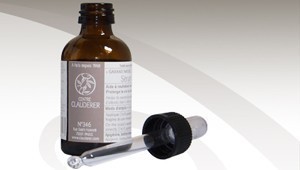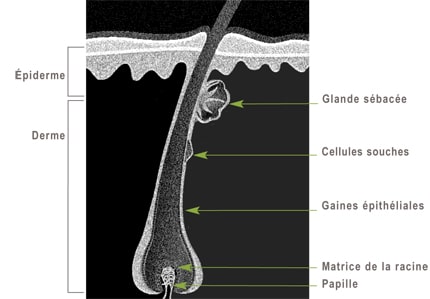"I'm losing my hair... it's thinning... it doesn't grow like it used to... How can I get my hair to really grow back?" These complaints account for more than 95 % of the problems reported by our Clauderer customers.
Whatever the origin of your hair loss (androgenism, stress, thyroid problems, deficiencies, etc.), the most important thing for us is to make sure that any hair that falls out is replaced by new growth that is stronger than the hair it replaces. Over the last five years, fortunately, the pace of discoveries in molecular biology has accelerated considerably. We now know exactly how the hair 'factory' works, and how to regrow hair…
THE UNDERGROUND HAIR FACTORY
Hair grows in the hair follicle, a small sac created by the epidermis folding back into the dermis, like the finger of an inverted glove. Implanted 4 mm deep, the follicle comprises different sites, all essential to hair production. Find out more about how the hair follicle works.
In fact, the hair follicle needs three mechanisms in good working order to produce a vigorous hair, ensure its renewal at the end of the cycle and produce identical regrowth. These mechanisms have been identified as the three vital functions of hair blood circulation to the roots, regeneration of hair stem cells, elimination of cellular waste produced by sebum.
WHEN THE MACHINE BREAKS DOWN...
There are several possible malfunctions in the hair production chain, for example in the case of androgen-related hair loss:
POOR ELIMINATION
Produced by the sebaceous gland, sebum often infiltrates the hair follicle, at the level of the epithelial sheaths and all around the matrix. This infiltration generates sebaceous impurities that clump around the roots and impede blood circulation.
POOR CIRCULATION
Reduced blood supply to the hair follicle. Insufficiently nourished, the root shrinks and produces hair that is less and less vigorous. At the same time, a negative enzyme (5 a-reductase), transmitted by the blood, also contributes to hair dysfunction by accelerating abnormally the work of the root.
DEGENERATION
Exhausted by too rapid a rate of production, the follicle matrix begins to botch keratinisation (hair production): cycles shorten, hair falls out faster, and growth and regrowth become increasingly thin. Eventually, some follicles end up producing nothing but fuzz, and then nothing at all.
Premature ageing of the epithelial sheaths (outer envelopes of the follicle), which are no longer able to anchor the developing stem and act as a support.
CARE TARGETED AT THE DYSFUNCTION
To treat hair dysfunctions of androgenetic origin, Clauderer has developed the CERES-1 and CERES-2 bio-complexes, which have given rise to Serums 6R and 7R. These two Serums are composed of five different plants, each with a specific role in the hair production chain.

For the first time on the market, two anti-hair loss products stimulate hair growth and regrowth by acting on all its production phases. Clauderer Serum 6R boosts blood circulation to the roots and reinforces keratin production, while inhibiting androgens. Serum 7R, on the other hand, focuses more on the regeneration of follicle tissue, in order to anchor the hair better and prevent premature hair loss. In clinical tests carried out at the Faculty of Medicine in Besançon, it proved to be more effective than minoxidil.
Far from being redundant, the two Serums complement each other, with the formula of Serum 6R focusing more on hair regrowth and that of Serum 7R on normalising hair loss.
Before undertaking any treatment, an in-depth hair diagnosis (with root and keratin analysis) can identify where and when vital functions have deteriorated. Today, this examination is essential for accurately targeting your treatment.
Your questions about hair regrowth
I'd like to have long hair but it's not growing fast enough. What can I do?
This symptom can have 2 distinct causes. Either your hair is not growing fast enough (average speed of hair growth per month = 1cm), or your hair is falling out before reaching full maturity. In the first case, we will use a vitamin-enriched treatment to help your hair roots produce more keratin. In the second case, the treatment will protect your hair from the negative influence of androgens.



Hello, insulin diabetic, very fine hair, lost a lot of hair, I don't like to go out any more, a lot of stress, I'd like help to find out why and to stop the loss, thank you in advance for your reply.
Hello and thank you for your message. We can help you regain healthier hair following a complete hair diagnosis. You can contact us for an appointment or fill in the form for a mail-order analysis - we look forward to hearing from you! The Clauderer Team
Hi, I gave birth 3 months ago by caesarean section and I'm losing a lot of hair, about 30 a day, not counting my clothes. But during my pregnancy I didn't lose any hair. What treatment can you recommend?
Thank you for your message and congratulations! As you may have read in our article "Pregnancy and hair loss", what you're describing is not at all surprising. A hair diagnosis would be advisable at this stage. Post-partum hair loss should not last more than 2/3 months. Once your hair assessment has been carried out, we'll be able to recommend the right treatment to help you regain healthy hair. See you soon. The Clauderer Team